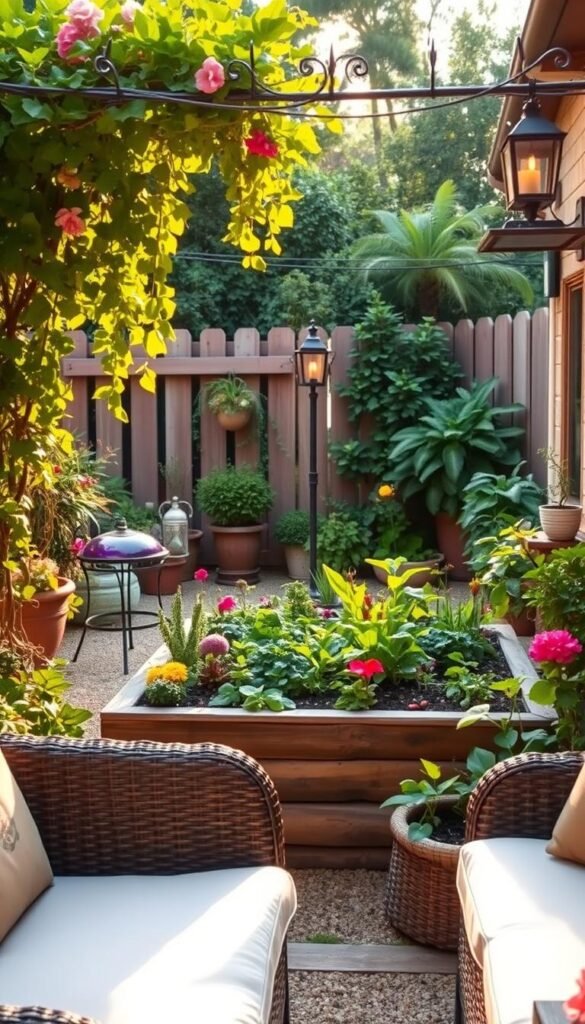Your outdoor area holds more potential than you might think. Even the most compact patios, narrow urban lots, or overlooked corners can become stunning retreats with smart planning. As designer Karen Chapman notes, “Beauty and practicality aren’t reserved for sprawling landscapes—they thrive where creativity meets intention.”
You don’t need acres to craft an inviting environment. Modern solutions let you layer textures, play with vertical elements, and choose plants that pull double duty. The secret? Treat every inch as valuable real estate.
This guide reveals how professionals transform cramped areas into functional escapes. You’ll learn to prioritize features that matter most—whether it’s privacy screening, dining zones, or vibrant blooms. We’ll explore space-stretching tricks like multi-level planters and reflective surfaces that add depth.
By the end, you’ll see how strategic layouts and clever storage turn limitations into advantages. Ready to reimagine your patch of green? Let’s unlock its hidden possibilities together.
Understanding the Potential of Small Gardens
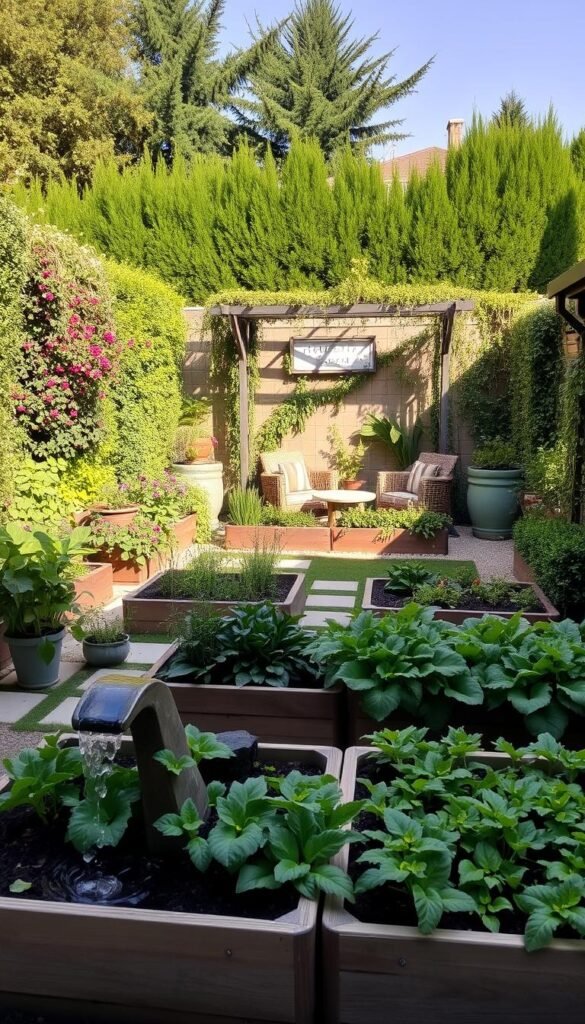
Even the coziest outdoor nook can become your favorite retreat when you match its design to your lifestyle. Start by asking: “What moments matter most here?” Whether hosting summer BBQs or sipping morning coffee alone, your space should reflect these priorities.
| Gathering Size | Recommended Space | Key Features |
|---|---|---|
| 2-4 people | 50-80 sq ft | Bistro set, vertical herbs |
| 6-8 guests | 100-150 sq ft | Foldable furniture, tiered planters |
| 10+ crowd | 200+ sq ft | Movable seating, built-in storage |
Smart small-space gardening strategies let one feature serve multiple purposes. A bench with hidden compartments stores tools while providing seating. Wall-mounted planters grow herbs and block unsightly views.
Professional designers suggest sketching your layout on grid paper first. Mark permanent structures, then experiment with movable elements. This helps identify underused corners perfect for a compact water feature or cocktail table.
Remember: Cozy spaces create memorable experiences. Your 10×10 patio can feel more inviting than a sprawling lawn when designed with intention. Focus on quality over quantity—three stunning pots make better conversation starters than a dozen mismatched containers.
Design Principles for Maximizing Tiny Outdoor Spaces
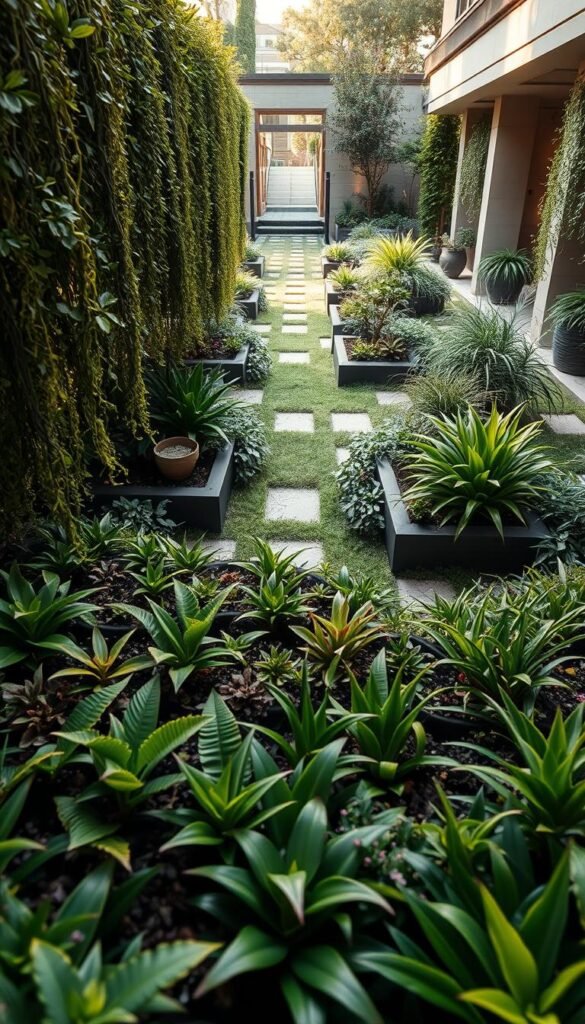
Smart design transforms cramped areas into inviting retreats. The secret lies in balancing living elements with structural features while tricking the eye to feel expansiveness. Start by applying the 50-50 rule: half your space for plants and seating, half for pathways or decking. This equilibrium prevents clutter while maintaining functionality.
Setting a Functional Layout
Shift perspectives using the diagonal axis technique. Angling your patio 45 degrees creates depth, making narrow plots appear wider. Landscape designer Mia Harrison explains: “Lines that pull the gaze across corners add visual mileage.” Align planting beds and walkways along this invisible line to maximize flow.
Balancing Planting and Hardscape
Divide your area into clear zones—dining, lounging, greenery. Use low walls or contrasting textures to define spaces without physical barriers. For patios, pair permeable pavers with container gardens that soften edges. Keep sightlines open by placing taller plants at the far end, drawing attention through the space rather than stopping it at boundaries.
Remember: every choice should serve multiple purposes. A bench with built-in storage becomes both seating and organizational tool. Strategic lighting placed behind foliage casts shadows that amplify depth after dark. These layered approaches make compact designs feel intentional, not cramped.
Creating a Focal Point with Statement Features
Every great outdoor area needs a visual anchor that pulls everything together. In compact layouts, your focal point becomes the star player—it draws attention while organizing the entire space. The trick? Choose features that command interest without dominating.
Using Water Features and Lighting
Moving water adds instant tranquility. A slim wall fountain or ceramic bowl with recirculating bubbles brings soothing sounds that mask traffic noise. Landscape architect Elena Cortez advises: “Even a modest water element creates rhythm—your eye follows its movement, making the area feel larger.”
Pair aquatic elements with layered lighting for evening magic. Solar-powered LED strips under benches highlight textures. String lights above seating zones cast warm glows. This combo turns daytime retreats into nighttime destinations.
Position your statement piece where multiple sightlines converge—near entryways or main seating areas work best. Keep proportions balanced: a 24-inch fountain suits 8×10 patios perfectly. Remember, your focal point should invite exploration, not block movement.
Tips for Functional and Cozy Patio Designs
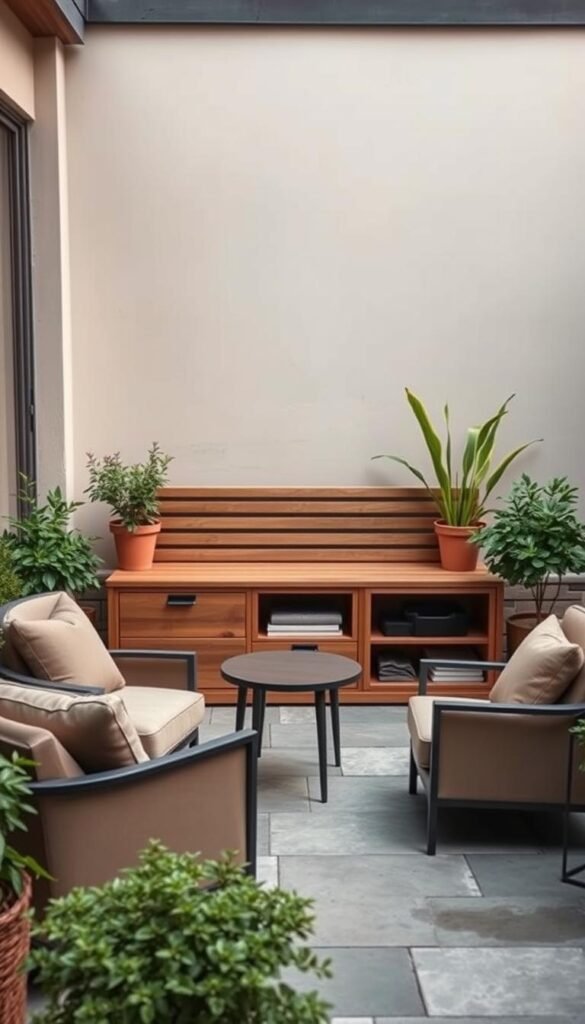
Compact patios become inviting extensions of your home when every element serves multiple purposes. Start by choosing pieces that work harder than they look—like foldable furniture that disappears when not in use or planters that moonlight as side tables.
Multipurpose Seating and Storage
Folding bistro sets shine in tight areas—they collapse flat against walls and weigh less than a vacuum cleaner. For meals with friends, try extending tables that grow from 30″ to 60″ with a simple pull. One designer swears by this trick: “Guests never notice the mechanism, just the extra elbow room.”
Built-in benches offer hidden storage under cushioned seats—perfect for stashing outdoor pillows or gardening tools. Retaining walls at 17-inch heights double as casual seating when topped with weather-resistant pads. Pair these with narrow tables that tuck neatly against railings.
Choose furniture with slim profiles to maintain walkways. A 24-inch-wide bench seats three adults comfortably without crowding the area. Add personality through creative gardening ideas like hanging herb planters that dress up blank walls while keeping spices within reach.
Finish with layered textiles: machine-washable cushions on main seats, folded blankets for chilly evenings, and an outdoor rug to define the space. These touches make your patio feel like an extra living room—just with better airflow.
Vertical Gardening and Space-Saving Planting Solutions
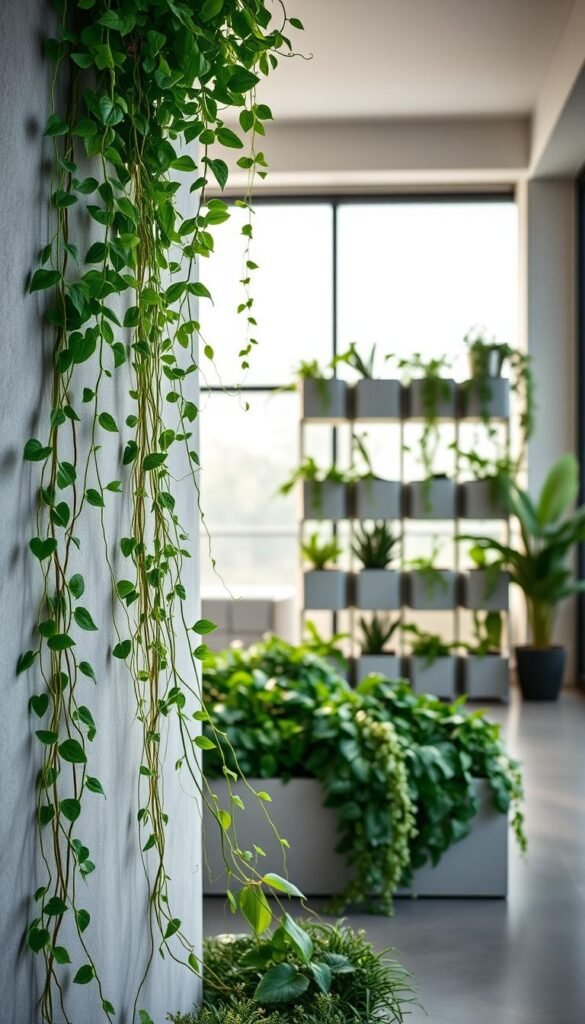
Looking up could be your garden’s secret weapon. Walls, fences, and overhead structures offer untapped real estate for greenery. By growing upward instead of outward, you create lush layers that maximize every square foot.
Elevated Planting Strategies
Hanging baskets turn blank walls into blooming displays. Stagger them at different heights to guide the eye upward. Mix trailing plants like petunias with upright varieties such as coleus for dynamic contrast. Pro tip: Use lightweight coco liners to reduce strain on hooks.
Transform flat surfaces into living art with modular green wall systems. These DIY-friendly panels let you grow herbs, succulents, or flowering plants vertically. Urban gardener Luis Torres shares: “My 4’x6′ herb wall produces enough basil for weekly pesto—and hides my neighbor’s AC unit.”
For narrow areas, try these space-stretching champions:
- Alliums: Their spherical blooms add height without bulk
- Verbena bonariensis: Airy purple flowers dance above other plants
- Climbing hydrangeas: Cover fences in three seasons of interest
Pair vertical elements with container gardens at ground level. This layered approach creates depth while keeping pathways clear. Install drip irrigation lines along walls to simplify watering—your plants will thrive with consistent moisture.
Maintenance matters: Rotate hanging baskets weekly for even sun exposure. Choose drought-tolerant varieties for south-facing walls. With smart vertical designs, your garden gains breathing room and visual impact simultaneously.
Choosing the Right Plants for Your Small Garden
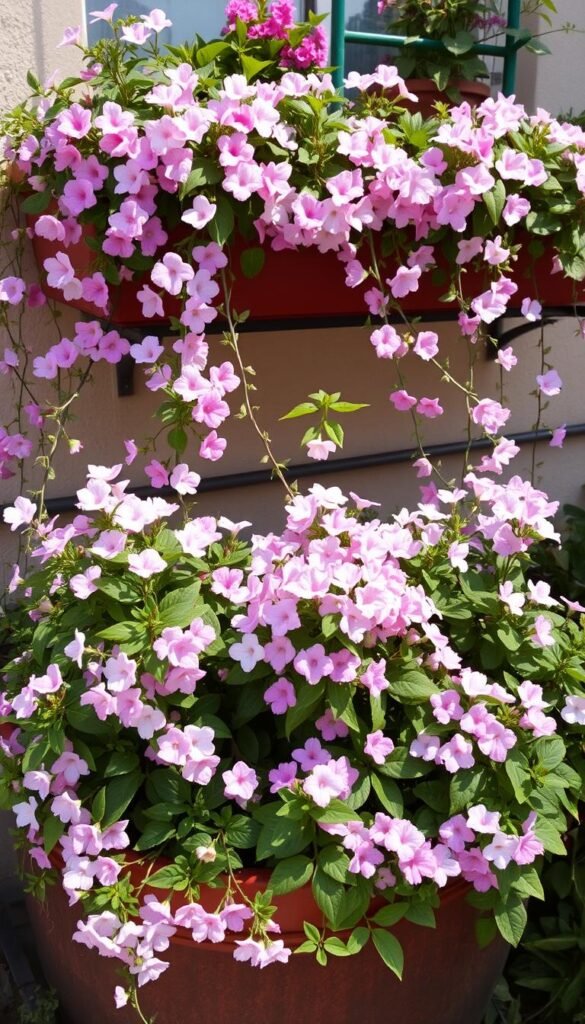
In compact areas, every plant must earn its place through beauty and utility. Focus on varieties that deliver multi-season interest while maintaining manageable sizes. This approach keeps your space lively from spring frosts to autumn leaves.
Compact and Long-Season Varieties
Prioritize plants that bloom for months, not weeks. Rosa ‘Flower Carpet Amber’ produces apricot-hued flowers from May through December in warmer zones. Pair it with Erigeron karvinskianus, whose daisy-like blooms shift from white to pink across three seasons.
| Plant Type | Bloom Period | Space Needs |
|---|---|---|
| Repeat-flowering roses | 5-8 months | 3-4 ft spread |
| Erysimum ‘Bowles’s Mauve’ | Year-round | 18″ width |
| Columnar apple trees | Spring flowers + fall fruit | 2 ft diameter |
Seasonal Color and Texture
Build a backbone of evergreen shrubs like boxwood before adding floral stars. Hardy geraniums offer billowy texture from June until frost, while Japanese maples add fiery fall color. For winter interest, try red-twig dogwood stems against evergreens.
Layer plants by height using vertical trees as focal points. A 10-foot coral bark maple fits narrow beds but provides year-round drama. Pair it with space-saving design techniques like staggered planting depths to maximize visual impact.
Remember: foliage matters as much as flowers. Silver-leaved artemisia and purple heuchera maintain color between bloom cycles. For patio displays, try container gardening strategies that let you rotate seasonal accents effortlessly.
Smart Storage and Seating for Limited Outdoor Areas
Limited square footage demands clever solutions that work twice as hard. Built-in benches become game-changers here, merging practical seating with hidden storage to free up your garden area. You’ll love how these designs keep essentials organized while creating inviting spots to relax.
Space-Saving Seating Concepts
Corner benches turn underused areas into cozy nooks. Flush-mounted against fences or walls, they eliminate the need for a central table while seating three adults comfortably. Add weather-resistant cushions in bold patterns to inject personality without clutter.
Opt for lift-top lids that reveal storage room for tools or outdoor pillows. One homeowner transformed their 6-foot bench into a gardening station by adding divided compartments underneath. This approach keeps supplies handy yet invisible when not in use.
For narrow patios, try slim-profile benches with backrests that double as vertical planters. You’ll gain greenery without sacrificing walkway space. Pair with budget-friendly garden upgrades like repurposed crates as side tables to complete the look.
Modular designs adapt as your needs change. Interlocking bench sections can expand for gatherings or condense for daily use. Remember: streamlined shapes and neutral colors help your garden area feel more spacious. With smart planning, every seat becomes a storage hero.

